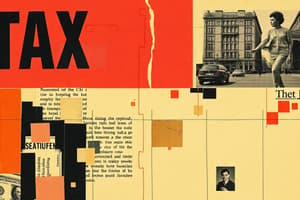Podcast
Questions and Answers
What does a change in the price of one commodity do to the budget line?
What does a change in the price of one commodity do to the budget line?
- It pivots the budget line anchoring on the commodity that did not change price. (correct)
- It shifts the budget line away from the origin.
- It causes the budget line to become steeper without affecting the total budget.
- It leads to a decrease in the total income available for spending.
How is marginal cost (MC) defined in the context of production?
How is marginal cost (MC) defined in the context of production?
- The total cost incurred in producing all units of output.
- The fixed costs associated with production excluding variable costs.
- The average cost of producing multiple units of output.
- The additional cost incurred in producing one extra unit of output. (correct)
What formula would you use to calculate average cost (AC)?
What formula would you use to calculate average cost (AC)?
- Total Cost x Quantity.
- Fixed Cost + Variable Cost.
- Total Cost / Quantity. (correct)
- Fixed Cost / Variable Cost.
If a firm produces 1000 units at a total cost of $10,000, what is the marginal cost of producing the 1001st unit if the total cost rises to $10,006?
If a firm produces 1000 units at a total cost of $10,000, what is the marginal cost of producing the 1001st unit if the total cost rises to $10,006?
What happens to total costs as output increases?
What happens to total costs as output increases?
What forms the Equal-Cost Curve or Isocost in production?
What forms the Equal-Cost Curve or Isocost in production?
Which combination results in the maximum units that can be purchased given a total cost of $6?
Which combination results in the maximum units that can be purchased given a total cost of $6?
What does the least-cost tangency represent in a production graph?
What does the least-cost tangency represent in a production graph?
Which scenario indicates a firm should continue production in a perfectly competitive market?
Which scenario indicates a firm should continue production in a perfectly competitive market?
How does the Law of Diminishing Marginal Product manifest in production?
How does the Law of Diminishing Marginal Product manifest in production?
What happens to the demand for good B if the price of good A increases?
What happens to the demand for good B if the price of good A increases?
What does the Marginal Revenue Product (MRP) equal under perfect competition?
What does the Marginal Revenue Product (MRP) equal under perfect competition?
How does the law of diminishing marginal utility affect the consumption of good A?
How does the law of diminishing marginal utility affect the consumption of good A?
What defines the concept of income elasticity?
What defines the concept of income elasticity?
What happens to the Labor Force Participation Rate (LFPR) when there is an increase in wage levels?
What happens to the Labor Force Participation Rate (LFPR) when there is an increase in wage levels?
What is the primary reason for the paradox of value, where essential commodities like water have low prices while luxury goods like diamonds are expensive?
What is the primary reason for the paradox of value, where essential commodities like water have low prices while luxury goods like diamonds are expensive?
Which of the following factors does NOT affect the Marginal Productivity of Labor?
Which of the following factors does NOT affect the Marginal Productivity of Labor?
In consumer theory, what distinguishes cardinal from ordinal utility?
In consumer theory, what distinguishes cardinal from ordinal utility?
What is the primary consequence of a minimum wage set above the equilibrium wage?
What is the primary consequence of a minimum wage set above the equilibrium wage?
Which statement best describes the concept of wage differentials?
Which statement best describes the concept of wage differentials?
Flashcards
Income effect
Income effect
The change in quantity demanded that arises because a price change lowers consumers' real incomes.
Substitution effect
Substitution effect
The change in quantity demanded due to a change in the relative price of one good compared to other goods.
Law of Diminishing Marginal Utility
Law of Diminishing Marginal Utility
This economic principle states that as consumption of a good increases, the marginal utility (satisfaction) gained from each additional unit decreases.
The Paradox of Value
The Paradox of Value
Signup and view all the flashcards
Income elasticity of demand
Income elasticity of demand
Signup and view all the flashcards
Total Costs (TC)
Total Costs (TC)
Signup and view all the flashcards
Marginal Cost (MC)
Marginal Cost (MC)
Signup and view all the flashcards
Average Cost (AC)
Average Cost (AC)
Signup and view all the flashcards
Average Fixed Cost (AFC)
Average Fixed Cost (AFC)
Signup and view all the flashcards
Isoquant
Isoquant
Signup and view all the flashcards
Isocost
Isocost
Signup and view all the flashcards
Least-Cost Tangency
Least-Cost Tangency
Signup and view all the flashcards
Law of Diminishing Marginal Product
Law of Diminishing Marginal Product
Signup and view all the flashcards
Shutdown Point (in Short Run)
Shutdown Point (in Short Run)
Signup and view all the flashcards
Substitution Effect of Labor
Substitution Effect of Labor
Signup and view all the flashcards
Income Effect of Labor
Income Effect of Labor
Signup and view all the flashcards
Labor Force Participation Rate
Labor Force Participation Rate
Signup and view all the flashcards
Employment Rate
Employment Rate
Signup and view all the flashcards
Unemployment Rate
Unemployment Rate
Signup and view all the flashcards
Study Notes
Marginal Analysis in a Nutshell
- Optimal Activity Level: Maximize an activity until marginal benefit equals marginal cost (zero marginal net yield).
- Relative Activity Levels: Allocate resources to activities with similar marginal benefits. Choose the option with the highest marginal net yield.
Totals, Averages, and Marginals: Arithmetic Relationships
- First Units: At the zeroth unit, total, average, and marginal values are all zero. If not zero, marginal values are still zero.
- Total and Marginal Relationship: Total is the sum of all preceding marginal values.
- Relationship between Average and Marginal: Average rises when marginal is above average and vice versa. Average stays constant when marginal equals average.
Geometry of Marginal Analysis: Total X Curves
- Average X and Total Curve: To find the average profit at a point, draw a line from the origin to that point on the graph and calculate its slope (rise/run).
- Marginal X and Total Curve: To find the marginal profit at a point, determine the slope of the tangent line at that point.
- Total X and Average Curve: The total cost of any quantity (OQ) is the area under the marginal cost curve above the line OQ.
Straight-line Marginal and Average Curves
- For average to rise, the marginal must be above average. Vice versa for average to fall. Marginal equals average when average is constant.
Total x and Marginal curve
- The total cost of producing OQ units of any commodity is the area under the marginal cost curve above the line OQ.
General Marginal and Average Curves
- A tangent line at a given point is used to determine the marginal.
- Extend the tangent line to the vertical axis and calculate the midpoint.
- A perpendicular line from the extended point to the horizontal axis passing through the midpoint is drawn.
Studying That Suits You
Use AI to generate personalized quizzes and flashcards to suit your learning preferences.




